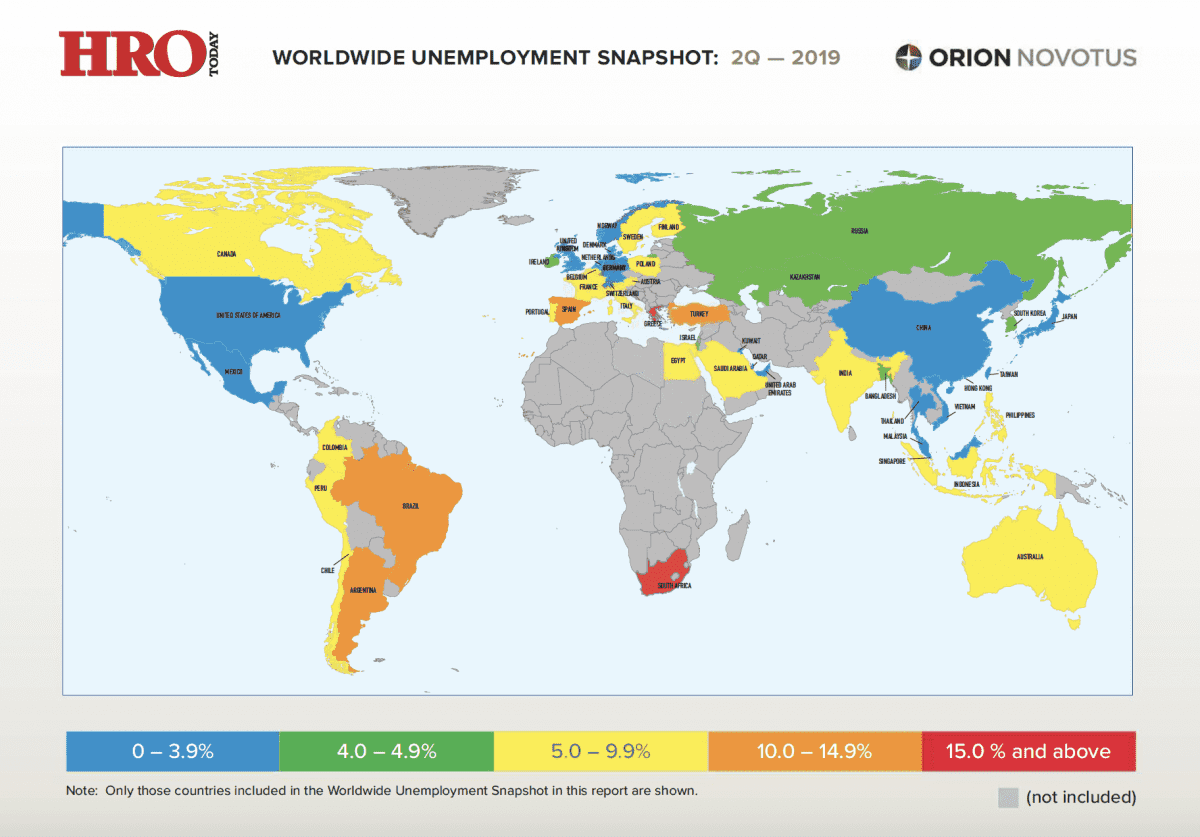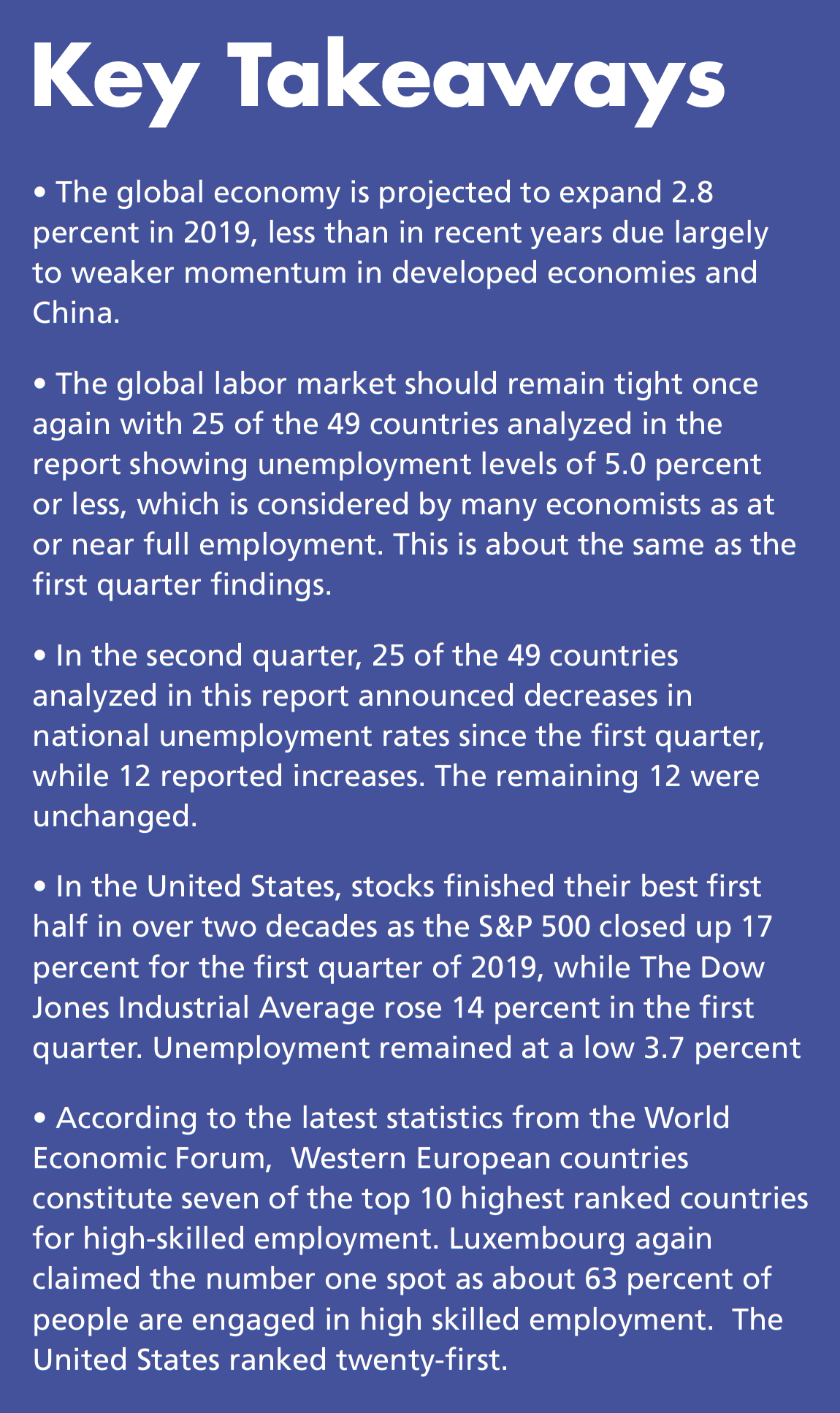Concern over the U.S.-China trade war has worldwide economies on edge.
By Larry Basinait
Deploying a global workforce and ensuring access to the best talent is a crucial component of success for all multinational enterprises. Global labor market intelligence is an invaluable tool for HR departments and can be used to inform critical decisions around the best countries and regions in which to grow. With that in mind, HRO Today and Orion Novotus, an Orion Talent company, partner to explain global unemployment rates by quarter.
To truly understand unemployment rates, it is necessary to collect several categories of market information about the overall economic environment from which they derive. For that reason, this report also analyzes measures that include GDP, economic forecasts, and other factors that offer insight into a given country’s economic circumstances.
Global growth dimmed in the second quarter of 2019. Weaker economies in developed nations and China continued to drag on as trade tensions rattled the global markets. However, accommodative monetary policy from various central banks helped sustain the current economic cycle in the short term, as many have hinted at cutting interest rates. Global inflation is expected to be lower in 2019 than in 2018, due to softer economic growth and as crude oil prices are expected to drop within the year, according to FocusEconomics.
In its semi-annual Global Economic Prospects report, the World Bank says global economic growth is projected to soften from an already downwardly revised 2.6 percent in 2019 amid rising downside risks to the outlook. However, advanced economies look to take most of the drop in growth as their numbers are projected to drop from 2.2 percent in 2018 to 2.0 percent in 2019. While growth in Emerging Markets and Developing Economies (EMDE) is projected to stay relatively fl at, GDP grew in 2018 to 4.2 percent and growth in 2019 is expected to stay the same, according to the World Bank.
But despite concerns about the global economy, the global unemployment rate currently stands at 5.0 percent and continues to fall for many countries. Not only do many companies around the world have a tighter pool of candidates to choose from when filling positions, but individuals are raising their standards regarding the companies and the roles that they consider. In fact, a majority of adults surveyed mentioned that they valued a company’s culture over salary and 70 percent of job seekers would not apply to a company unless it aligned with their own personal values, reports Fortune.

United States and Canada
A tight labor market continued in the United States as the unemployment rate stayed near historic lows. While consumer optimism remained relatively high within the ongoing economic expansion, the Consumer Confidence Index in June of 2019 fell to the lowest level since the third quarter of 2017 as trade tensions continued and some consumers faced recessionary fears. However, June marked the 11th straight month where average hourly earnings increased by at least 3 percent compared to the previous year, according to a White House report. As consumers have more money in their pockets, they generally are more inclined to spend money which drives economic growth.
In June, the U.S. unemployment rate was 3.7 percent, which marks the sixth consecutive quarter with an unemployment rate of 4.0 or less. U.S. stocks finished their best first half in over two decades, despite having a somewhat volatile second quarter in 2019. In the first half of the year, the S&P 500 increased 17 percent while The Dow Jones Industrial Average rose 14 percent, marking the best first halves since 1997 and 1999, respectively. The run-up in the markets has been largely attributed to investors speculating that the Federal Reserve will cut interest rates and overcoming an escalation in the U.S.-China trade fight, reports Yahoo Finance.
The Canadian unemployment rate decreased by 0.3 percent from the first quarter of 2019 to 5.5 percent in the second quarter as 250,000 net new jobs were created in the first five months of the year. While business confidence returned to positive territory within the first quarter of the year, household debt reached nearly 15 percent of disposable income, reports National Bank of Canada. A rise in household debt leaves consumers with less disposable income to use on new purchases as they pay off debt, as well as an increased chance of default.
Asia-Pacific (APAC)
 According to a FocusEconomics estimate, the ESA region (East and South Asia) is expected to face headwinds this year from slow global growth and rising global trade protectionism as the region is highly susceptible to a Chinese economic slowdown. However, higher growth in Bangladesh and India should help accelerate growth in the near term.
According to a FocusEconomics estimate, the ESA region (East and South Asia) is expected to face headwinds this year from slow global growth and rising global trade protectionism as the region is highly susceptible to a Chinese economic slowdown. However, higher growth in Bangladesh and India should help accelerate growth in the near term.
China has by far the largest economy in the region with a GDP of $13.4 trillion and is nearly three times larger than the second biggest economy in the region Japan. The Chinese economy grew at the weakest pace since 1992 as the trade war continued to undermine the external sector and investment growth, despite bank lending increasing within the quarter. However, in late June, China and the U.S. agreed to restart trade negotiations and the U.S. canceled new tariffs on Chinese exports. Economists forecast the Chinese economy to grow at 6.2 percent in 2019.
Europe, the Middle East, and Africa (EMEA)
The EMEA region covers three continents and includes 116 different countries, which vary greatly in GDP and population. Twenty-seven countries in EMEA are tracked in this quarterly analysis. There were mixed results in the quarter with unemployment rates in the overall EMEA region declining, year-over-year, in 18 of the 27 countries examined here. The biggest decline in the unemployment rate was in Turkey, where the unemployment rate declined by 1.7 percentage points for the quarter, though that only partially offset the year-over-year unemployment rate that rose 2.9 percentage points. South Africa’s already high unemployment rate increased in the second quarter to 29.0 percent, up 1.4 percent.
In the second quarter of 2019, growth within Europe lost momentum, after a healthy start to the year, as the manufacturing sector slowed to its weakest quarter since 2013, causing economic sentiment to fall to a three-year low. However, activity within business services rose to a seven-month high as the unemployment rate continued to fall in 15 of the 27 countries within the region compared to the last quarter. The Eurozone region is expected to grow at 1.1 percent in 2019, according to FocusEconomics.
The United Kingdom has the second largest economy in Europe at $2.8 trillion dollars. FocusEconomics reports second quarter growth as nearly nonexistent, sapped by swirling Brexit uncertainty as manufacturers destocked following a surge in inventories in the first quarter. The labor market remained a silver lining, however, since between March and May there was the fastest wage growth since 2008 and the unemployment rate stayed at a multi-decade low of 3.8 percent.
Latin America
Latin America’s growth outlook was cut for the fourth consecutive month in July, part of an overall poor first half of 2019. A challenging global environment, plagued by persistent trade tensions and slowing consumer spending, is seen as holding back activity. Internal issues, such as Argentina’s economic adjustment, policy uncertainty in Mexico, and declining confidence also contributed to the downbeat outlook, reports FocusEconomics.














